Marrying Vega and Zen: The AMD Ryzen 5 2400G Review
by Ian Cutress on February 12, 2018 9:00 AM ESTBenchmarking Performance: CPU System Tests
Our first set of tests is our general system tests. These set of tests are meant to emulate more about what people usually do on a system, like opening large files or processing small stacks of data. This is a bit different to our office testing, which uses more industry standard benchmarks, and a few of the benchmarks here are relatively new and different.
All of our benchmark results can also be found in our benchmark engine, Bench.
PDF Opening
First up is a self-penned test using a monstrous PDF we once received in advance of attending an event. While the PDF was only a single page, it had so many high-quality layers embedded it was taking north of 15 seconds to open and to gain control on the mid-range notebook I was using at the time. This put it as a great candidate for our 'let's open an obnoxious PDF' test. Here we use Adobe Reader DC, and disable all the update functionality within. The benchmark sets the screen to 1080p, opens the PDF to in fit-to-screen mode, and measures the time from sending the command to open the PDF until it is fully displayed and the user can take control of the software again. The test is repeated ten times, and the average time taken. Results are in milliseconds.
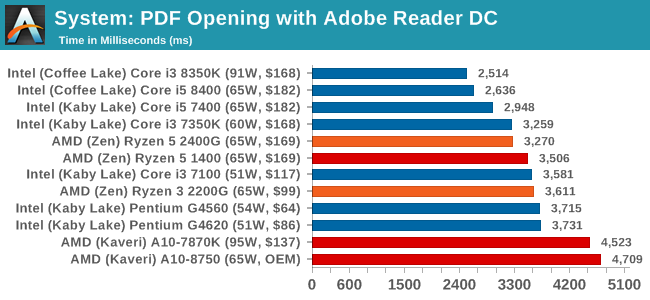
Our PDF test relies mostly on single core frequency, but memory frequency can also help. The 2400G pips the 1400, and the older AMD processors take a back seat. This is the sort of test that Intel's 4.2 GHz chips can take advantage off, as shown by the Core i3-8350K.
FCAT Processing: link
One of the more interesting workloads that has crossed our desks in recent quarters is FCAT - the tool we use to measure stuttering in gaming due to dropped or runt frames. The FCAT process requires enabling a color-based overlay onto a game, recording the gameplay, and then parsing the video file through the analysis software. The software is mostly single-threaded, however because the video is basically in a raw format, the file size is large and requires moving a lot of data around. For our test, we take a 90-second clip of the Rise of the Tomb Raider benchmark running on a GTX 980 Ti at 1440p, which comes in around 21 GB, and measure the time it takes to process through the visual analysis tool.
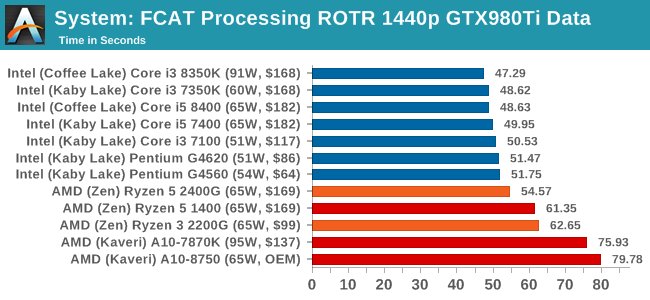
The FCAT program is single threaded, so again Intel's chips take a win here. The Ryzen 5 2400G takes another chunk out of the Ryzen 5 1400, due to its higher frequency.
Dolphin Benchmark: link
Many emulators are often bound by single thread CPU performance, and general reports tended to suggest that Haswell provided a significant boost to emulator performance. This benchmark runs a Wii program that ray traces a complex 3D scene inside the Dolphin Wii emulator. Performance on this benchmark is a good proxy of the speed of Dolphin CPU emulation, which is an intensive single core task using most aspects of a CPU. Results are given in seconds, where the Wii itself scores 1,052 seconds (17.53 minutes).
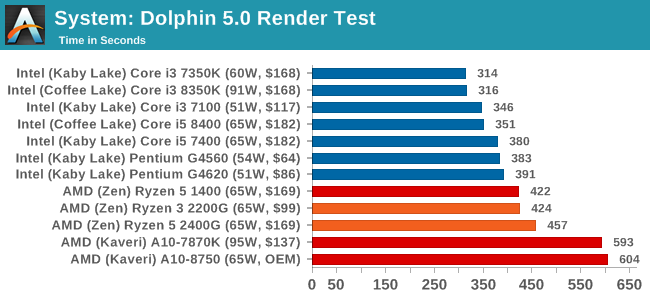
3D Movement Algorithm Test v2.1: link
This is the latest version of the self-penned 3DPM benchmark. The goal of 3DPM is to simulate semi-optimized scientific algorithms taken directly from my doctorate thesis. Version 2.1 improves over 2.0 by passing the main particle structs by reference rather than by value, and decreasing the amount of double->float->double recasts the compiler was adding in. It affords a ~25% speed-up over v2.0, which means new data.
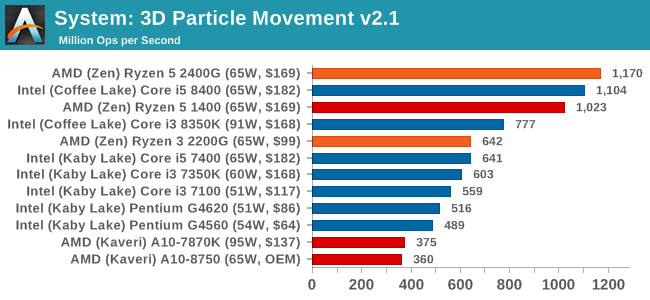
3DPM is our first multi-threaded test, and the Ryzen 5 2400G powers ahead over the 1400 due to frequency, and ahead the Core i3-8350K due to thread count. This is a benchmark that can take advantage of multithreading, so the quad-core APU with eight threads pushes ahead of the six-core Intel Core i5-8400.
DigiCortex v1.20: link
Despite being a couple of years old, the DigiCortex software is a pet project for the visualization of neuron and synapse activity in the brain. The software comes with a variety of benchmark modes, and we take the small benchmark which runs a 32k neuron/1.8B synapse simulation. The results on the output are given as a fraction of whether the system can simulate in real-time, so anything above a value of one is suitable for real-time work. The benchmark offers a 'no firing synapse' mode, which in essence detects DRAM and bus speed, however we take the firing mode which adds CPU work with every firing.
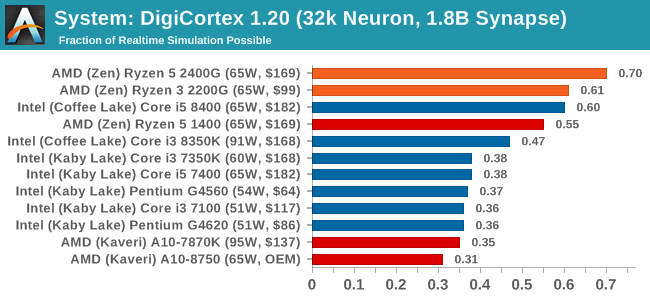
Agisoft Photoscan 1.3.3: link
Photoscan stays in our benchmark suite from the previous version, however now we are running on Windows 10 so features such as Speed Shift on the latest processors come into play. The concept of Photoscan is translating many 2D images into a 3D model - so the more detailed the images, and the more you have, the better the model. The algorithm has four stages, some single threaded and some multi-threaded, along with some cache/memory dependency in there as well. For some of the more variable threaded workload, features such as Speed Shift and XFR will be able to take advantage of CPU stalls or downtime, giving sizeable speedups on newer microarchitectures.
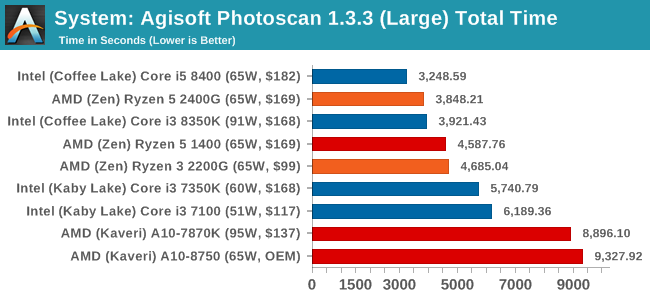
For Photoscan, certain elements of the algorithms require full cores to get the best performance, hence why the six-core CPU comes top and the Ryzen 5 2400G and Core i3-8350K are matched. That being said, the multithreading of the 2400G outweighs the extra frequency of the 8350K.










177 Comments
View All Comments
Fritzkier - Tuesday, February 13, 2018 - link
Well not really. While they using Pentium G with GT 730 or lower, many uses AMD A-series APU too (since they no need to use low end discrete GPU to be on par)And Ryzen 2200G also priced the same as Pentium G with GT 730 tho. The exception is RAM prices...
watzupken - Tuesday, February 13, 2018 - link
If AMD uses a beefier Vega IGPU, are you willing to pay for it is the question? I feel iGPU will only make sense if the price is low, or if the power consumption is low. Where Intel is using AMD graphics, is likely for a fruity client. Outside of that, you won't see many manufacturers using it because of the cost. For the same amount of money Intel is asking for the chip only, there are many possible configuration with dedicated graphics that you can think of. Also, the supposedly beefier AMD graphics is about as fast as a GTX 1050 class. You are better off buying a GTX 1050Ti.iwod - Tuesday, February 13, 2018 - link
Well unless we could solve the GPU Crypto problem in the near future ( Which we wont ) I think having better Vega GFx combined with CPU is good deal.Gadgety - Monday, February 12, 2018 - link
Will these APUs do HDR UHD 4k Bluray playback (yes I know it's a tiny niche), or is that still Intel only?GreenReaper - Wednesday, February 14, 2018 - link
Probably best to just get an Xbox One S for it. As a bonus you could play a few games on it, too!watzupken - Tuesday, February 13, 2018 - link
I feel the R3 2200G is still a better deal than the R5 2400G. The price gap is too big relative to the difference in performance. And because these chips are over clocking friendly, so despite the R3 being a cut down chip, there could be some performance catchup with some overclocking. Overall, I feel both are great chips especially for some light/ casual gaming. If gaming is the main stay, then there is no substitute for a dedicated graphic solution.serendip - Tuesday, February 13, 2018 - link
The 2200G is a sweet because it offers most of the 2400G's performance at a sub-$100 point. For most business and home desktops, it's more than enough for both CPU and GPU performance. And with discrete GPUs being so hard to get now, good-enough APU graphics will do for the majority of home users. Hopefully AMD can translate all this into actual shipping machines.I'm going to sound like a broken record but AMD could send another boot up Intel's behind by making an Atom competitor. A dual-core Zen with SMT and cut-down Vega graphics would still be enough to blow Atom out of the water.
msroadkill612 - Tuesday, February 13, 2018 - link
Its a pity they dont get hbcc.msroadkill612 - Tuesday, February 13, 2018 - link
Simply put, amd now own the entry level up to most 1080p gaming, and its a daunting jump in cost to improve by much.Its polite and nice of this review to pretend intel has competitive products, and include them for old times sake.
serendip - Tuesday, February 13, 2018 - link
Looks like AMD owns the good-enough category. As I said previously, let's hope this translates into actual machines being shipped, seeing as OEMs previously made some terrible AMD-based systems at the low end.